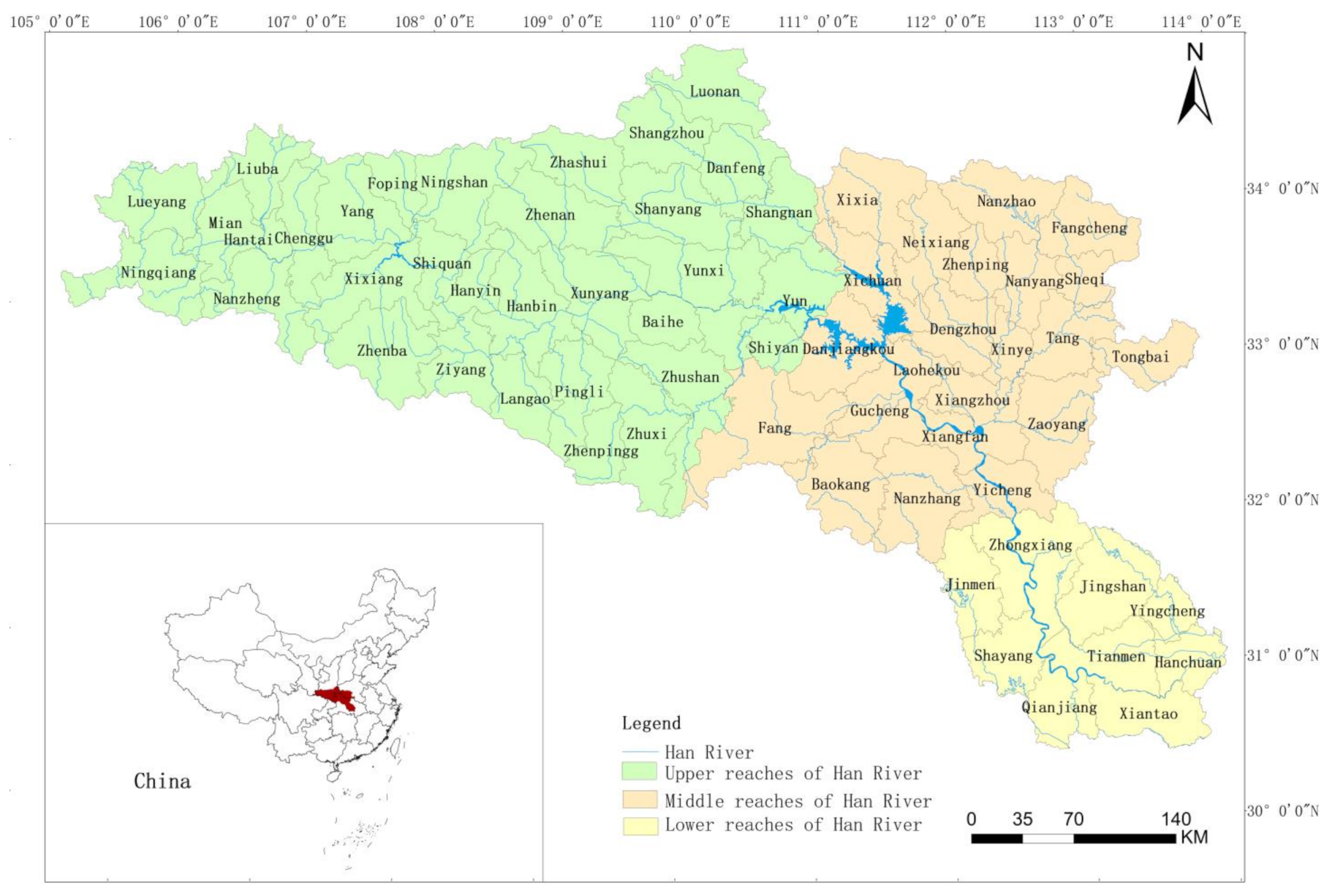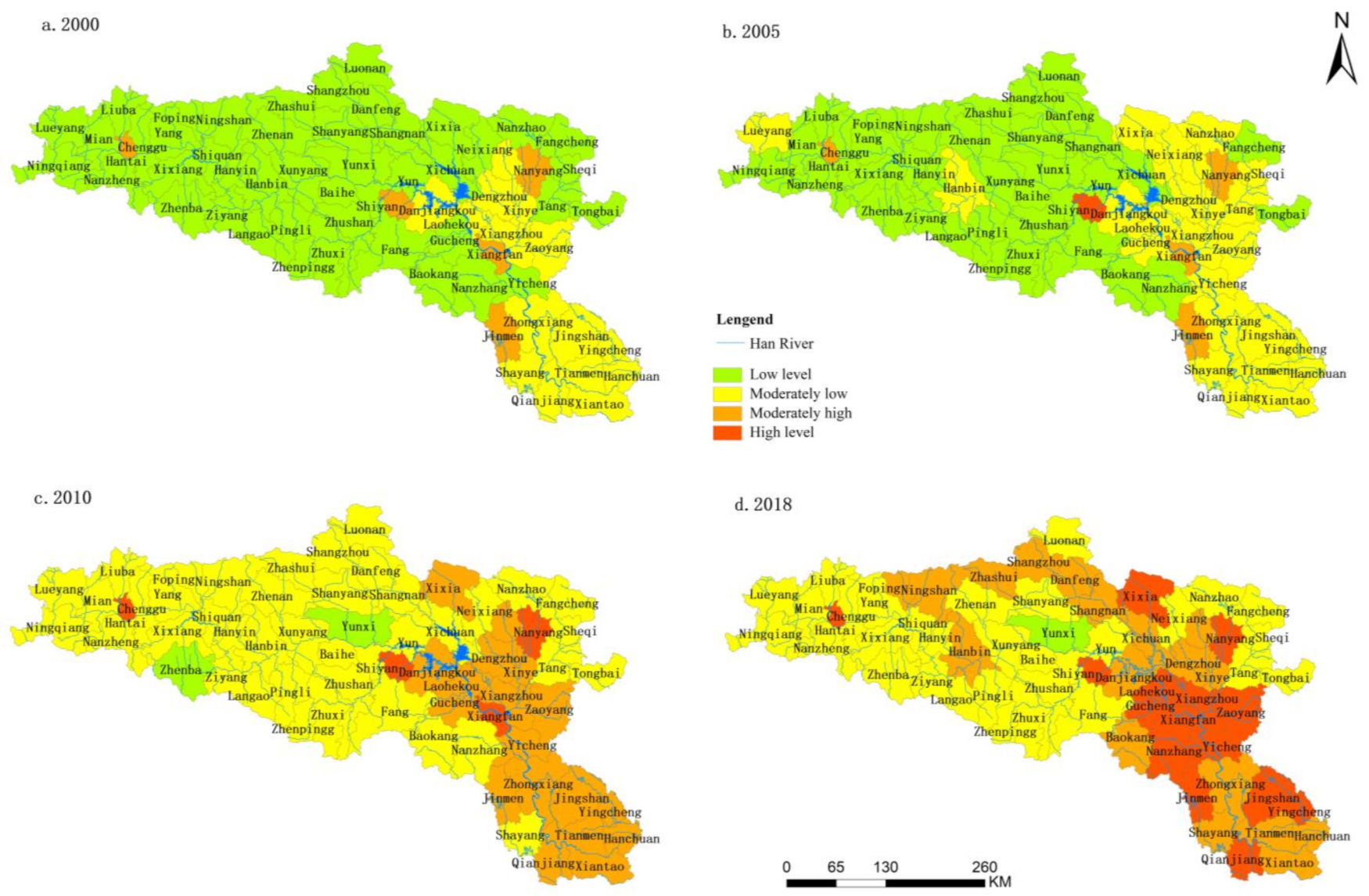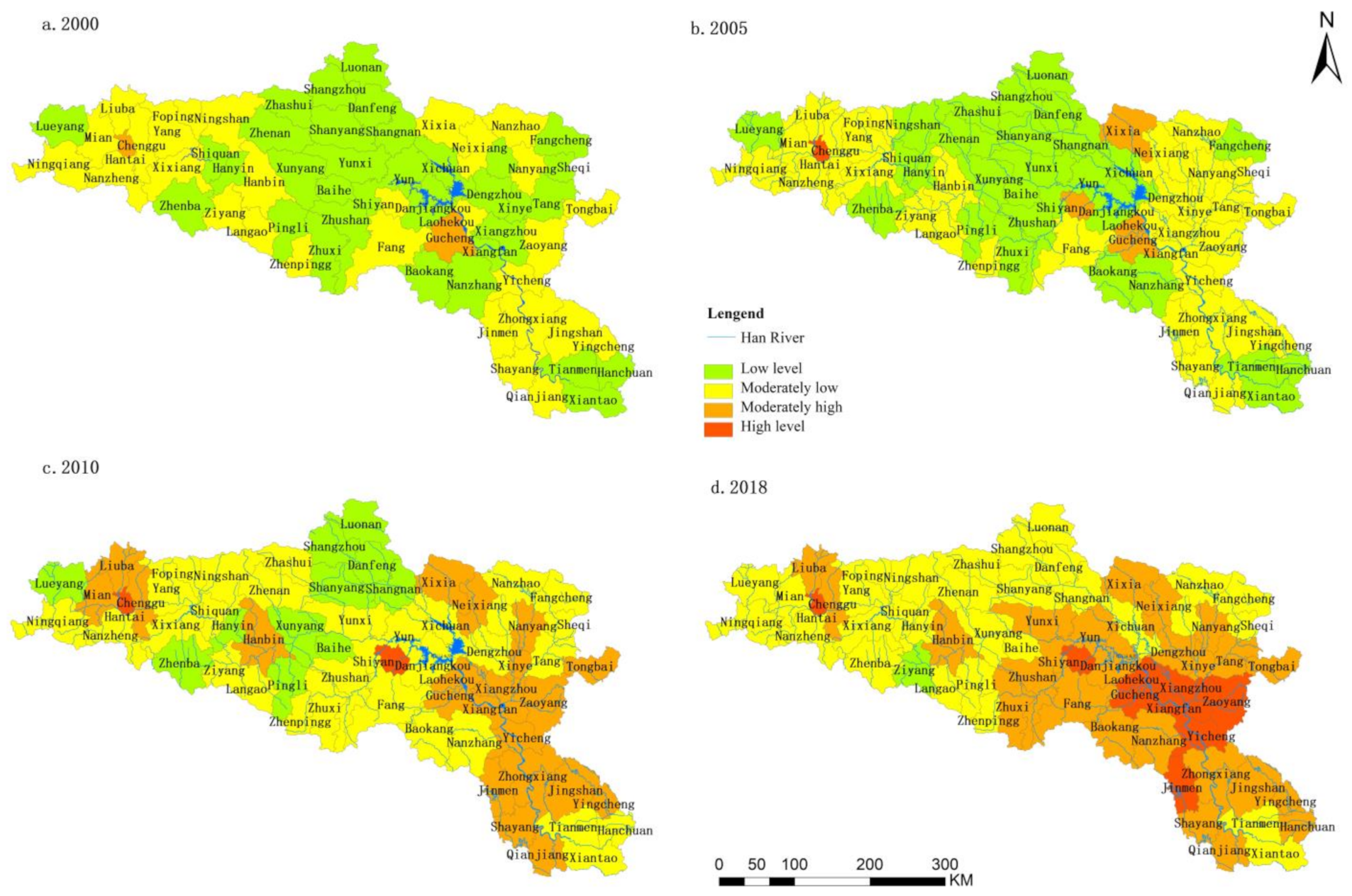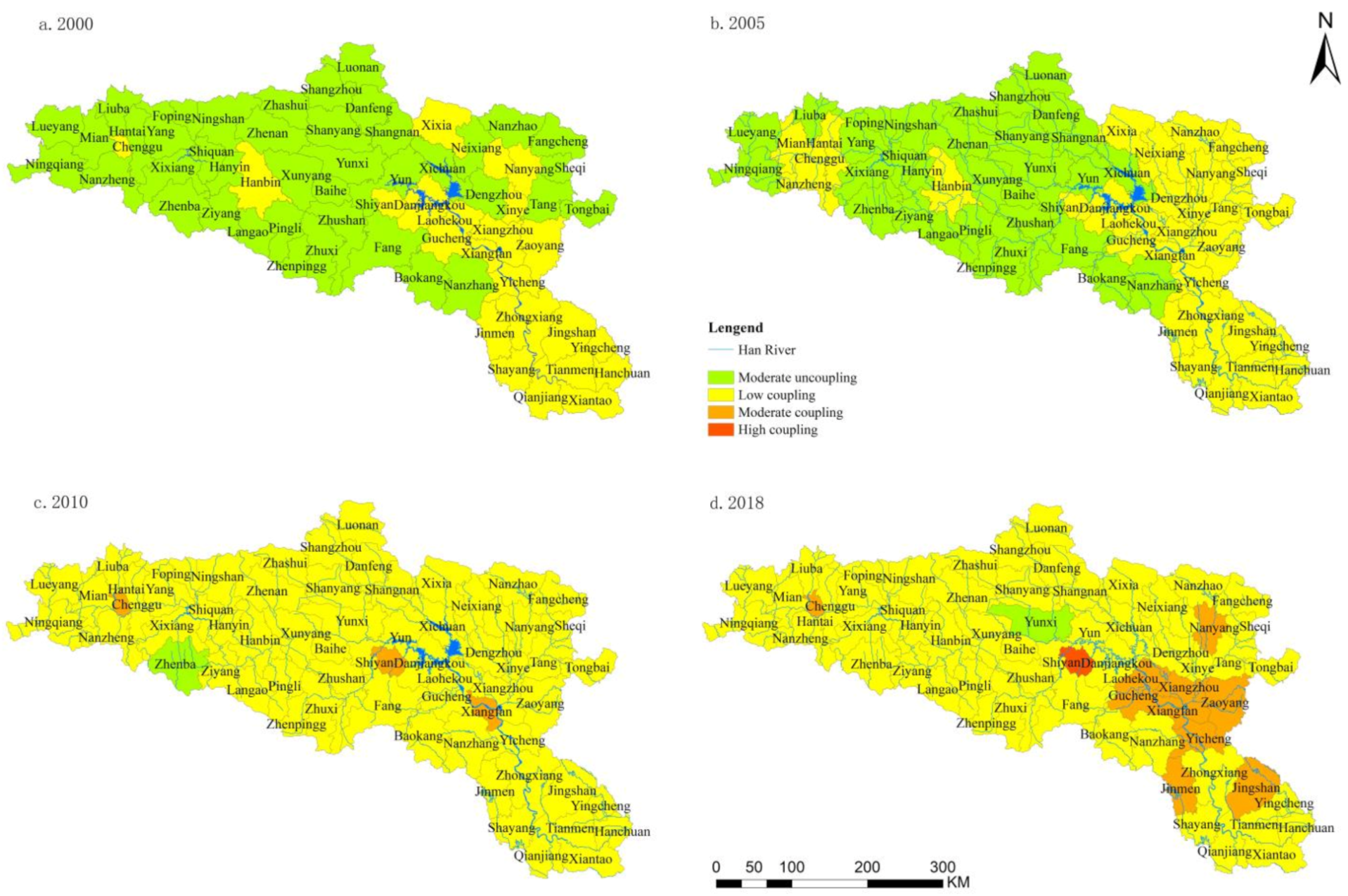Interaction Relationship between Urbanization and Land Use Multifunctionality: Evidence from Han River Basin, China
Abstract
:1. Introduction
2. Study Area and Data Source
2.1. Study Area
2.2. Data Source
3. Methods
3.1. Index System
3.2. Index Weight Setting and Score Calculation
3.2.1. Data Standardization
3.2.2. Weight Calculation
- (1)
- The entropy method
- (2)
- Principal component analysis
- (3)
- Composite index
3.3. Coupling Coordination Degree Model (CCDM)
3.4. Geographical Detector
4. Results
4.1. Spatiotemporal Change of Urbanization and LUMF
4.1.1. Spatiotemporal Change of Urbanization
4.1.2. Spatiotemporal Change of LUMF
4.2. Coupling Analysis of Urbanization and LUMF
4.2.1. Temporal Characteristics of the Coupling Coordination between Urbanization and LUMF
4.2.2. The Spatial Characteristics of the Coupling Coordination between Urbanization and LUMF
4.3. Research on the Mechanism of Influence between Urbanization and LUMF
4.3.1. Exploring the Impact of Urbanization on LUMF from the Perspective of Demand
4.3.2. Exploring the Impact of LUMF on Urbanization from the Perspective of Supply
5. Discussion
5.1. Coupling Relationship of Urbanization and LUMF
5.2. The Internal Influence of Urbanization and LUMF
5.3. Limitations
6. Conclusions
Author Contributions
Funding
Institutional Review Board Statement
Informed Consent Statement
Data Availability Statement
Conflicts of Interest
References
- Friedmann, J. Four theses in the study of China’s urbanization. Int. J. Urban Reg. Res. 2006, 30, 440–451. [Google Scholar] [CrossRef]
- Xu, F.; Wang, Z.; Chi, G.; Zhang, Z. The impacts of population and agglomeration development on land use intensity: New evidence behind urbanization in China. Land Use Policy 2020, 95, 104639. [Google Scholar] [CrossRef]
- Hong, T.; Yu, N.; Mao, Z.; Zhang, S. Government-driven urbanisation and its impact on regional economic growth in China. Cities 2021, 117, 103299. [Google Scholar] [CrossRef]
- Luo, Y.; Xiang, P.; Wang, Y. Investigate the Relationship between Urbanization and Industrialization using a Coordination Model: A Case Study of China. Sustainability 2020, 12, 916. [Google Scholar] [CrossRef] [Green Version]
- Fan, W.; Wang, H.; Liu, Y.; Liu, H. Patio-temporal variation of coupling relationship between urbanization development and air quality: A case study of Shandong Province. J. Clean. Prod. 2020, 272, 122812. [Google Scholar] [CrossRef]
- Guo, K.; Li, S.; Wang, Z.; Shi, J.; Bai, J.; Cheng, J. Impact of Regional Green Development Strategy on Environmental Total Factor Productivity: Evidence from the Yangtze River Economic Belt, China. Int. J. Environ. Res. Public Heal. 2021, 18, 2496. [Google Scholar] [CrossRef]
- Wu, Y.; Zhang, X.; Shen, L. The impact of urbanization policy on land use change: A scenario analysis. Cities 2011, 28, 147–159. [Google Scholar] [CrossRef]
- Gong, J.; Liu, Y.; Chen, W. Land suitability evaluation for development using a matter-element model: A case study in Zengcheng, Guangzhou, China. Land Use Policy 2012, 29, 464–472. [Google Scholar] [CrossRef]
- You, H. Impact of urbanization on pollution-related agricultural input intensity in Hubei, China. Ecol. Indic. 2016, 62, 249–258. [Google Scholar] [CrossRef]
- Zhang, Y. Multiple-use forestry vs. forestland-use specialization revisited. For. Policy Econ. 2005, 7, 143–156. [Google Scholar] [CrossRef]
- Zhen, L.; Cao, S.; Wei, Y.; Xie, G.; Li, F. Land Use Functions: Conceptual Framework and Application for China. Resour. Sci. 2009, 31, 544–551. (In Chinese) [Google Scholar]
- Hermanns, T.; Helming, K.; König, H.J.; Schmidt, K.; Li, Q.; Faust, H. Sustainability impact assessment of peatland-use scenarios: Confronting land use supply with demand. Ecosyst. Serv. 2017, 26, 365–376. [Google Scholar] [CrossRef]
- Soja, E.W. Regional urbanization and third wave cities. City 2013, 17, 688–694. [Google Scholar] [CrossRef]
- Brown, I.; Castellazzi, M. Scenario analysis for regional decision-making on sustainable multifunctional land uses. Reg. Environ. Chang. 2014, 14, 1357–1371. [Google Scholar] [CrossRef]
- Reidsma, P.; König, H.J.; Feng, S.; Bezlepkina, I.; Nesheim, I.; Bonin, M.; Sghaier, M.; Purushothaman, S.; Sieber, S.; van Ittersum, M.; et al. Methods and tools for integrated assessment of land use policies on sustainable development in developing countries. Land Use Policy 2011, 28, 604–617. [Google Scholar] [CrossRef]
- Purushothaman, S.; Patil, S.; Francis, I.; König, H.J.; Reidsma, P.; Hegde, S. Participatory impact assessment of agricultural practices using the land use functions framework: Case study from India. Int. J. Biodivers. Sci. Ecosyst. Serv. Manag. 2012, 9, 2–12. [Google Scholar] [CrossRef]
- Du, G.M.; Sun, X.B.; Wang, J.Y. Spatiotemporal patterns of multi-functionality of land use in Northeast China. Prog. Geogr. 2016, 35, 232–244. [Google Scholar]
- Zhou, D.; Xu, J.; Lin, Z. Conflict or coordination? Assessing land use multi-functionalization using production-living-ecology analysis. Sci. Total. Environ. 2017, 577, 136–147. [Google Scholar] [CrossRef]
- De Rudolf, G. Function-analysis and Valuation as a Tool to Assess Land Use Conflicts in Planning for Sustainable, Multi-functional Landscapes. Landsc. Urban Plan. 2006, 75, 175–186. [Google Scholar]
- Liang, Z.; He, Z.; Zhou, X.; Powell, C.A.; Yang, Y.; He, L.M.; Stoffella, P.J. Impact of mixed land-use practices on the microbial water quality in a subtropical coastal watershed. Sci. Total. Environ. 2013, 449, 426–433. [Google Scholar] [CrossRef] [PubMed]
- Fleskens, L.; Duarte, F.; Eicher, I. A conceptual framework for the assessment of multiple functions of agroecosystems: A case study of Trás-os-Montes olive groves. J. Rural. Stud. 2009, 25, 141–155. [Google Scholar] [CrossRef] [Green Version]
- Tao, J.; Fu, M.; Sun, J.; Zheng, X.; Zhang, J.; Zhang, D. Multifunctional assessment and zoning of crop production system based on set pair analysis-A comparative study of 31 provincial regions in mainland China. Commun. Nonlinear Sci. Numer. Simul. 2014, 19, 1400–1416. [Google Scholar] [CrossRef]
- Zhou, D.; Xu, J.; Wang, L.; Lin, Z. Assessing urbanization quality using structure and function analyses: A case study of the urban agglomeration around HangzhouBay (UAHB), China. Habitat Int. 2015, 49, 165–176. [Google Scholar] [CrossRef]
- Wu, C.J. The core of study of geography: Man-land relationship areal system. Econ. Geograp. 1991, 11, 1–6. [Google Scholar]
- Delphin, S.; Escobedo, F.; Abd-Elrahman, A.; Cropper, W. Urbanization as a land use change driver of forest ecosystem services. Land Use Policy 2016, 54, 188–199. [Google Scholar] [CrossRef] [Green Version]
- Han, X.; Zhang, A.; Cai, Y. Spatio-Econometric Analysis of Urban Land Use Efficiency in China from the Perspective of Natural Resources Input and Undesirable Outputs: A Case Study of 287 Cities in China. Int. J. Environ. Res. Public Heal. 2020, 17, 7297. [Google Scholar] [CrossRef] [PubMed]
- Wang, S.; Ma, H.; Zhao, Y. Exploring the relationship between urbanization and the eco-environment—A case study of Beijing–Tianjin–Hebei region. Ecol. Indic. 2014, 45, 171–183. [Google Scholar] [CrossRef]
- Liu, J.; Dietz, T.; Carpenter, S.R.; Alberti, M.; Folke, C.; Moran, E.; Pell, A.N.; Deadman, P.; Kratz, T.; Lubchenco, J.; et al. Complexity of coupled hu-man and natural systems. Science 2007, 317, 1513–1516. [Google Scholar] [CrossRef] [Green Version]
- Cen, X.; Wu, C.; Xing, X.; Fang, M.; Garang, Z.; Wu, Y. Coupling intensive land use and landscape ecological security for urban sustainability: An integrated socioeconomic data and spatial metrics analysis in Hangzhou city. Sustainability 2015, 7, 1459–1482. [Google Scholar] [CrossRef] [Green Version]
- Wang, J.; Wang, S.; Li, S.; Feng, K. Coupling analysis of urbanization and energy-environment efficiency: Evidence from Guangdong province. Appl. Energy 2019, 254, 113650. [Google Scholar] [CrossRef]
- Zhang, Z.; Chang, T.; Qiao, X.; Yang, Y.; Guo, J.; Zhang, H. Eco-Economic Coordination Analysis of the Yellow River Basin in China: Insights from Major Function-Oriented Zoning. Sustainability 2021, 13, 2715. [Google Scholar] [CrossRef]
- Ding, L.; Zhao, W.; Huang, Y.; Cheng, S.; Liu, C. Research on the Coupling Coordination Relationship between Urbanization and the Air Environment: A Case Study of the Area of Wuhan. Atmosphere 2015, 6, 1539–1558. [Google Scholar] [CrossRef] [Green Version]
- Zhang, Z.; Li, Y. Coupling coordination and spatiotemporal dynamic evolution between urbanization and geological hazards–A case study from China. Sci. Total. Environ. 2020, 728, 138825. [Google Scholar] [CrossRef] [PubMed]
- Tang, Z. An integrated approach to evaluating the coupling coordination between tourism and the environment. Tour. Manag. 2015, 46, 11–19. [Google Scholar] [CrossRef]
- Ding, Y.; Zhang, M.; Qian, X.; Li, C.; Chen, S.; Wang, W. Using the geographical detector technique to explore the impact of socioeconomic factors on PM2.5 concentrations in China. J. Clean. Prod. 2019, 211, 1480–1490. [Google Scholar] [CrossRef]
- Wang, J.F.; Zhang, T.L.; Fu, B.J. A measure of spatial stratified heterogeneity. Ecol. Indic. 2016, 67, 250–256. [Google Scholar] [CrossRef]
- Wang, J.F.; Li, X.H.; Christakos, G.; Liao, Y.L.; Zhang, T.; Gu, X.; Zheng, X.Y. Geographical detectors-based health risk assessment and its application in the neural tube defects study of the Heshun region, China. Int. J. Geogr. Inf. Sci. 2010, 24, 107–127. [Google Scholar] [CrossRef]
- He, J.; Wang, S.; Liu, Y.; Ma, H.; Liu, Q. Examining the relationship between urbanization and the eco-environment using a coupling analysis: Case study of Shanghai, China. Ecol. Indic. 2017, 77, 185–193. [Google Scholar] [CrossRef]
- Huang, J.; Lin, H.; Qi, X. A literature review on optimization of spatial development pattern based on ecological-production-living space. Prog. Geogr. 2017, 36, 378–391. [Google Scholar]
- Fan, Y.; Jin, X.; Xiang, X.; Liu, J.; Yang, X.; Zhou, Y. Land use functions change and its spatial pattern in Jiangsu province from 2000 to 2015. Geogr. Res. 2019, 38, 193–208. (In Chinese) [Google Scholar]
- Fu, B.J.; Zhao, W.; Chen, L.D.; Zhang, Q.J.; Lü, Y.H.; Gulinck, H.; Poesen, J. Assessment of soil erosion at large watershed scale using RUSLE and GIS: A case study in the Loess Plateau of China. Land Degrad. Dev. 2005, 16, 73–85. [Google Scholar] [CrossRef]
- He, C.; Zhang, D.; Huang, Q.; Zhao, Y. Assessing the potential impacts of urban expansion on regional carbon storage by linking the LUSD-urban and InVEST models. Environ. Model. Softw. 2016, 75, 44–58. [Google Scholar] [CrossRef]
- Li, Y.; Li, D. Assessment and forecast of Beijing and Shanghai’s urban ecosystem health. Sci. Total. Environ. 2014, 487, 154–163. [Google Scholar] [CrossRef] [PubMed]
- Qi, Z.-F.; Ye, X.-Y.; Zhang, H.; Yu, Z.-L. Land fragmentation and variation of ecosystem services in the context of rapid urbanization: The case of Taizhou city, China. Stoch. Environ. Res. Risk Assess. 2013, 28, 843–855. [Google Scholar] [CrossRef]
- Price, A.L.; Patterson, N.J.; Plenge, R.M.; Weinblatt, E.M.; Shadick, A.N.; Reich, D. Principal components analysis corrects for stratification in genome-wide association studies. Nat. Genet. 2006, 38, 904–909. [Google Scholar] [CrossRef] [PubMed]
- Gao, S.; Zhao, H.; Bai, Z.; Han, B.; Xu, J.; Zhao, R.; Zhang, N.; Chen, L.; Lei, X.; Shi, W.; et al. Combined use of principal component analysis and artificial neural network approach to improve estimates of PM2.5 personal exposure: A case study on older adults. Sci. Total. Environ. 2020, 726, 138533. [Google Scholar] [CrossRef]
- Liu, N.; Liu, C.; Xia, Y.; Da, B. Examining the coordination between urbanization and eco-environment using coupling and spatial analyses: A case study in China. Ecol. Indic. 2018, 93, 1163–1175. [Google Scholar] [CrossRef]
- Ariken, M.; Zhang, F.; Liu, K.; Fang, C.; Kung, H.-T. Coupling coordination analysis of urbanization and eco-environment in Yanqi Basin based on multi-source remote sensing data. Ecol. Indic. 2020, 114, 106331. [Google Scholar] [CrossRef]
- Guo, Y.; Zhang, X.; Wang, Q.; Chen, H.; Du, X.; Ma, Y. Temporal changes in vegetation around a shale gas development area in a subtropical karst region in southwestern China. Sci. Total. Environ. 2020, 701, 134769. [Google Scholar] [CrossRef] [PubMed]
- Qi, X.; Si, Z.; Zhong, T.; Huang, X.; Crush, J. Spatial determinants of urban wet market vendor profit in Nanjing, China. Habitat Int. 2019, 94, 102064. [Google Scholar] [CrossRef]
- Wang, J.F.; Haining, R.; Liu, T.J.; Li, L.-F.; Jiang, C.-S. Sandwich estimation for multi-unit reporting on a stratified heterogeneous surface. Environ. Plan. A 2013, 45, 2515–2534. [Google Scholar] [CrossRef] [Green Version]
- Peng, J.; Liu, Z.; Liu, Y.; Hu, X.; Wang, A. Multifunctionality assessment of urban agriculture in Beijing City, China. Sci. Total. Environ. 2015, 537, 343–351. [Google Scholar] [CrossRef] [PubMed]
- Li, J.; Zhang, H.; Sun, Z. Spatiotemporal variations of land urbanization and socioeconomic benefits in a typical sample zone: A case study of the Beijing-Hangzhou Grand Canal. Appl. Geogr. 2020, 117, 102187. [Google Scholar] [CrossRef]
- Sun, P.L.; Xu, Y.Q.; Liu, Q.G.; Liu, C.; Huang, A. Spatiotemporal differentiation and driving factors of multi-functionality of land use in county scale in poverty belt around Beijing and Tianjin. Trans. Chin. Soc. Agric. Eng. 2017, 33, 283–292. (In Chinese) [Google Scholar]





| Data | Resolution | Source |
|---|---|---|
| Soil Map | Raster; 1 km | China Soil Map Based on Harmonized World Soil Database (v1.1). Available online: http://westdc.westgis.ac.cn/ (accessed on 25 Juanary 2021). |
| Normalized Difference Vegetation Index data (NDVI) | Raster; 1 km | Resource and Environment Data Cloud Platform. Available online: http://www.resdc.cn/ (accessed on 20 Juanary 2021) |
| Digital Elevation Model (DEM) | Raster; 30 m | Geospatial Data Cloud. Available online: http://www.giscloud.cn/ (accessed on 28 Juanary 2021) |
| Precipitation Data | Vector; 30 m | China Meteorological Data Sharing Service System. Available online: http://data.cma.cn/ (accessed on 15 Juanary 2021) |
| Land Use/Land Cover | Raster; 30 m × 30 m | Geospatial Data Cloud. Available online: http://www.giscloud.cn/ (accessed on 21 Juanary 2021) |
| Grain Output | Statistics | Hubei/Shannxi/Henan Statistical Yearbook |
| Socioeconomic Data | Statistics | China’s County Statistical Yearbooks |
| Layer of Target | Criterion Level | Index Level | Attribute | Weight |
|---|---|---|---|---|
| Urbanization | Population urbanization | Population density (people/) () | + | 0.0915 |
| Population urbanization rate (%) () | + | 0.0748 | ||
| Economic urbanization | Secondary and tertiary industry output value account for GDP (%) () | + | 0.0380 | |
| Real GDP per capita (RMB/person) () | + | 0.0976 | ||
| Local government revenue per capita (RMB/person) () | + | 0.1270 | ||
| Fixed-asset investment per capita (RMB/person) () | + | 0.1141 | ||
| Social urbanization | Average salary of employees (RMB) () | + | 0.0698 | |
| Total retail sales of consumer goods per capita (RMB) () | + | 0.1064 | ||
| Disposable income ratio of urban and rural residents (%) () | − | 0.0609 | ||
| Number of beds in hospitals and health centers (beds) () | + | 0.1086 | ||
| Highway density () | + | 0.1113 | ||
| Land use multifunctionality | Agricultural production function | Food output per capita (t/person) () | + | 0.0851 |
| Per capita gross output value of agriculture, forestry, animal husbandry and fisheries (RMB/person) () | + | 0.0896 | ||
| Cultivated land area per capita (m2/person) () | + | 0.0604 | ||
| Town living function | GDP per unit area (RMB10,000/) () | + | 0.1906 | |
| Industry employees per unit area (people/) () | + | 0.1938 | ||
| Government expenditure per unit area (RMB10,000/) () | + | 0.1642 | ||
| Ecological maintenance function | Carbon stock () | + | 0.0692 | |
| Soil erosion () | − | 0.0472 | ||
| Forest cover rate (%) () | + | 0.0999 |
| D | Coupling State | Characteristics |
|---|---|---|
| 0.8 < D ≤ 1 | High coupling | The benign coupling between urbanization and LUMF increases toward orderly development. |
| 0.6 < D ≤ 0.8 | Moderate coupling | Urbanization and LUMF begin to cooperate and balance with each other. |
| 0.4 < D ≤ 0.6 | Low coupling | The interactions between urbanization and LUMF strengthen. |
| 0.2 < D ≤ 0.4 | Moderate uncoupling | Urbanization and LUMF development show a weak imbalance. |
| 0 < D ≤ 0.2 | Severe uncoupling | Urbanization and LUMF development show a serious imbalance. |
| Criterion Level | Index Level | Whole Region q-Value | Upstream q-Value | Midstream–Downstream q-Value |
|---|---|---|---|---|
| Population urbanization | Population density | 0.5253 ** | 0.8306 ** | 0.2874 |
| Population urbanization rate | 0.4582 | 0.6007 | 0.4272 | |
| Economic urbanization | Secondary and tertiary industry output value account for GDP | 0.2557 | 0.5097 | 0.1783 |
| Real GDP per capita | 0.6316 *** | 0.6437 | 0.7151 ** | |
| Local government revenue per capita | 0.5670 | 0.6040 | 0.4292 | |
| Fixed-asset investment per capita | 0.3254 | 0.6304 | 0.3387 | |
| Social urbanization | Average salary of employees | 0.1403 | 0.2211 | 0.2663 |
| Total retail sales of consumer goods per capita | 0.7142 *** | 0.8599 ** | 0.4488 | |
| Disposable income ratio of urban and rural residents | 0.3208 * | 0.0314 | 0.4336 | |
| Number of beds in hospitals and health centers | 0.5148 *** | 0.8435 *** | 0.2373 | |
| Highway density | 0.2583 | 0.2572 | 0.0649 |
| Criterion Level | Index Level | Whole Stream q-Value | Upstream q-Value | Midstream-Downstream q-Value |
|---|---|---|---|---|
| Agricultural production function | Food output per capita | 0.2234 | 0.3971 | 0.0809 |
| Per capita gross output value of agriculture, forestry, animal husbandry and fisheries | 0.2480 * | 0.3566 | 0.2570 | |
| Cultivated land area per capita | 0.4740 ** | 0.8056 *** | 0.4113 | |
| Town living function | GDP per unit area | 0.7864 *** | 0.9617 *** | 0.5832 |
| Industry employee per unit area | 0.7838 *** | 0.9507 *** | 0.7178 | |
| Government expenditure per unit area | 0.6320 *** | 0.7946 *** | 0.4297 | |
| Ecological maintain function | Carbon stock | 0.1771 | 0.2126 | 0.0762 |
| Soil erosion | 0.2366 | 0.1128 | 0.5415 | |
| Forest cover rate | 0.0762 | 0.0877 | 0.1826 |
Publisher’s Note: MDPI stays neutral with regard to jurisdictional claims in published maps and institutional affiliations. |
© 2021 by the authors. Licensee MDPI, Basel, Switzerland. This article is an open access article distributed under the terms and conditions of the Creative Commons Attribution (CC BY) license (https://creativecommons.org/licenses/by/4.0/).
Share and Cite
Gao, Y.; Li, H.; Song, Y. Interaction Relationship between Urbanization and Land Use Multifunctionality: Evidence from Han River Basin, China. Land 2021, 10, 938. https://doi.org/10.3390/land10090938
Gao Y, Li H, Song Y. Interaction Relationship between Urbanization and Land Use Multifunctionality: Evidence from Han River Basin, China. Land. 2021; 10(9):938. https://doi.org/10.3390/land10090938
Chicago/Turabian StyleGao, Yanli, Hongbo Li, and Yan Song. 2021. "Interaction Relationship between Urbanization and Land Use Multifunctionality: Evidence from Han River Basin, China" Land 10, no. 9: 938. https://doi.org/10.3390/land10090938
APA StyleGao, Y., Li, H., & Song, Y. (2021). Interaction Relationship between Urbanization and Land Use Multifunctionality: Evidence from Han River Basin, China. Land, 10(9), 938. https://doi.org/10.3390/land10090938






